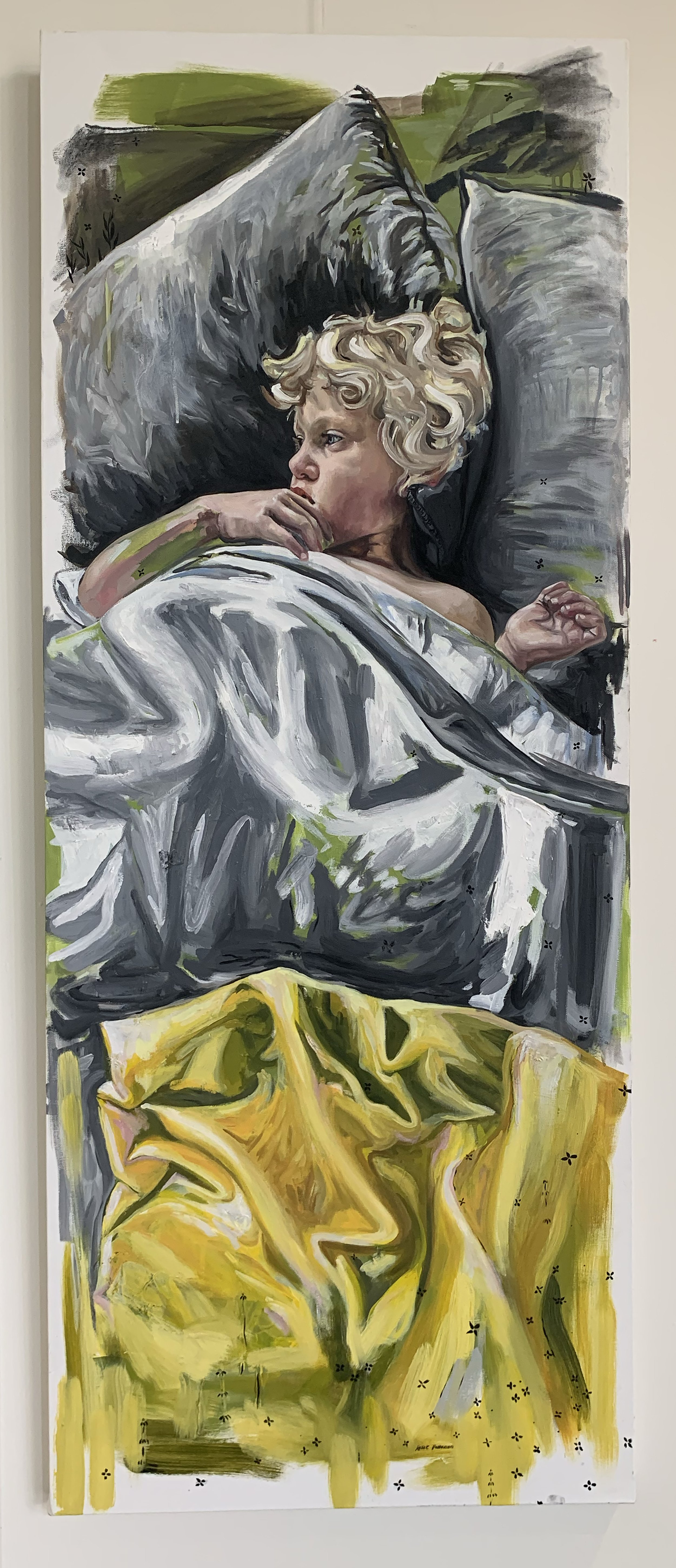IB VISUAL ARTS 2022
Rosie pettenon
Throughout my childhood my mother would commonly encourage my family to practise gratefulness. This has become a normal part of my day, and I realised that my expression of gratitude can be practised not only through words but through my art making. Reflection is a prominent part of daily life that when practised aids with critical thinking, problem solving, motivation, and most of all happiness. As stated by psychologists at Harvard University “gratitude is strongly and consistently associated with greater happiness” and “helps people feel more positive emotions, relish good experiences, improve their health, deal with adversity, and build strong relationships”. The positivity associated with these outcomes are themes I recognised in my own grateful practise, and I loved the idea of practising and sharing my gratitude through my artworks. These ideas prompted the concept behind my exhibition: an exploration of gratitude.
The most significant concept of my exhibition is my expression and investigation of gratitude, my art making an avenue for practising this. I aim to not only express my own gratitude, but invite the viewer to reflect on how they may similarly practise it in their own life. I hope that visually, my works impact the viewer as a comforting and positive sensory experience. I aim to achieve this predominantly through oil painting, which I prefer as an art form both technically and aesthetically. The fluidity and expression that can be achieved through painting is an aesthetic I aspire to, with limited brush strokes implying movement, but also realism. Warm colours of pink and red were used throughout the paintings to evoke emotions of love and happiness. These were also complimented by strong hues of greens and blues, linking emotions of calmness and serenity to the ideas of gratitude. I worked predominantly with portraiture because of the capability to portray more than just the appearance of a person. I aimed to capture each person’s culture, personality, and even the wider societal and cultural context surrounding them. The time I have spent painting the portraits of my friends, cousins, and immediate family in special places has encouraged me to reflect on their individual personalities and the aspects of our relationship that I value.
The positioning of the exhibition allows for ideas to be communicated in two ways. Firstly from the centre of the exhibition, the viewer is faced with my full length self-portrait. The mirror like reflection explores the concept of reflecting on one self and the components that have contributed to our identity. The exhibition is presented in a circular shape where the self-portrait is hung at the highest point, encouraging the eyes of the viewer to move in a triangular shape downwards to the surrounding artworks. The looseness of the works simultaneously increase as the eyes are lead outwards. The circular composition of the exhibition allows for it to be viewed as a timeline, where the first painting represents the simplicity of childhood with time increasing as the eyes move to the right. As the viewer progresses, the child builds the memories and experiences that grow them into the centre self-portrait, the paintings become symbolic of the times she is grateful for and the contributors to her identity. The central self-portrait is hugged by paintings depicting family, as these are the people I am most grateful for and hence wanted them in a close proximity to the centre of the exhibition. Leading to the right side, two paintings depicting school life are placed on easels. The Class of 2022 is placed behind Mr Foley to emphasise the hierarchical themes of school.
Despite the majority of the exhibition representing positive themes of gratitude, the sculpture ‘cracking gratefulness’ considers how negative aspects of life make us appreciate the good. How can we understand what is good without having something to compare it to? This artwork refers to the physical resolution of understanding the benefits of grateful practice, as well as referring to the importance of being grateful for what we have, as we never know when life could change. This sculpture contrasts to A Sunny Morning, which positioned on the opposite side of the exhibition represents memories that we do remember thankfully.
Overall I hope that my exhibition is visually pleasing and evokes emotions of happiness when presented with bright colours and positive subject matter.

Ordinary things
Oil on Canvas
150 x 60 cm
Inspired by the simplicity of childhood, this painting reflects the ‘ordinary’ moments in life that children find such wonder and joy within. Such simplicity comes easily whilst young, and I aim for the viewer to reflect on their own childhood as they peer into this girl’s moment in time. Reflecting on and savouring memories of childhood help our understanding of who we have become, as these experiences have paved the way for our present selves.

I can see it in plein air
Oil on canvas board
3 x 30.5 x 40.5 cm each
Denoting the French impressionist technique of “plein air” painting, I can see it in plein air encourages the viewer to connect with the places which form their experiences in life. Inspired by the naturalistic views of the pre-Raphaelite brotherhood, I aspired to capture the environment in its true state. The indigenous names printed on the painting connotes the traditional owners and names of the land, and the importance of connecting and reflecting on the land which is prevalent to their culture.

A Sunny Morning
Ceramic tiles, grout, plywood, adhesive
120 x 59 x 3.5cm
Inspired by stained glass windows, the mosaic depicts sunlight streaming through a window in the early morning of my grandparents vineyard. This artwork represents gratitude for times of the past, that exist now only through our memories. The vines are romanticised as perfectly ripe, as these moments are remembered only positively, even though when we experienced them they did not seem so perfect. Therefore the work suggests we must appreciate every moment for its positives, as it could become the fondness of our past.

Holy Moly!
Oil paint and pen on canvas
76 x 120 cm
Initially inspired by the TV show Holy Moly, the painting depicts a handmade golf course created by my family, highlighting collaboration and the appreciation of experience and time spent together. The four faces depict my brother, father, cousin, and uncle, who created the course organically and through shared passion. Surrounding their portraits is an aerial bird’s eye view of our coastal holiday house and the symbols surrounding their portrait are all representative of fond memories.

Self Portrait
Oil on canvas
150 x 60cm
The self-portrait central to the exhibition was painted as a representation of my identity, and the avenues that have built me into the person I am today. Throughout the process of painting my works I used one apron to wipe my brushes. By painting this apron in my self-portrait, the aspects of my gratitude are represented in the apron coming together to form my identity. The mirror like scale of the painting alludes to reflection, and the idea that gratefulness is reflecting on yourself and life, which I have done through my exhibition.

Love letters to my family
Oil on paper
6 x 20 x 28 cm
This series of portrait paintings interprets my perspective of my family in a heavenly view. The pink backgrounds, clouds and hearts express how grateful I am for having a loving and supportive family. I felt that it wouldn’t be right to not devote artworks to them when exploring what I am grateful for. I included the symbolism of hearts and clouds to emphasise these ideas, but also comically highlight how practising gratefulness can sometimes appear trite and clichéd.

Cracking gratefulness
Pen, and printed labels on glass.
Graphite on printed paper.
20 x 28 x 22 (found object with writing)
Drawing 20 x 13.5 cm
Cracking gratefulness refers to the physical resolution of understanding the benefits of grateful practise, and refers to the importance of being grateful for what we have, as at any moment life could ‘crack’ and change. Referencing the effects of dementia, the wine bottle represents my grandmother’s mind, its inability to hold liquid a symbol of her inability to hold memories. The drawing that complements the sculpture depicts Granny prior to her diagnosis, representing the importance of being grateful for the life we have and have had, as change is imminent at any moment.

Class of 22
Oil on plywood
90 x 60cm
The collage of student’s faces demonstrates the community and collaboration of a school environment. By positioning each person on top of one another, I intended to communicate the lively but also overwhelming effects of school. As well as this, each person is one of my close friends and represent the love and friendship that I have gained and am very grateful for over my school years. However, they are representative of the whole class of 22 whom have all contributed to my school experience.

A Principals Principle
Oil on plywood
90 x 60 cm
The painting title plays on the words principle, as both a revered position within the school and the values that are taught by this position. The painting is a portrayal of the traditions of my school inspired by oil painting portraits depicting past principals. The dark background and formal attire represents these works and the traditional ideologies of the school, yet his comfortable expression, stance, and the students in the background, present a twist on the way leaders are traditionally portrayed and represents his modern teaching style.

